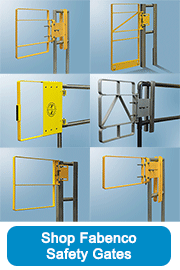
In this first entry of our ongoing Indoor Fall Protection FAQ Series, we’re going to focus on that mainstay of almost any industrial fall protection plan, the safety gate. Regardless of how common they are, you probably have a few questions about the OSHA requirements for safety gates. You’re not alone. Here are some of the questions we are frequently asked:
What are the OSHA requirements for indoor fall protection?
Before focusing purely on safety gates, let’s review the basics. In general industry, staying in compliance with OSHA guidelines for fall protection requires the use of guardrails, safety gates, warning lines, or other fall protection devices. While your duty is to protect workers anytime they are performing their duties 4′ above the surface below, that’s just the beginning. You also need to make sure workers have adequate fall protection for exposed holes in the floor or walls, ladderways and staircases, around machinery, and anywhere a fall hazard is recognized.
Are safety gates required by OSHA?
As with most fall safety equipment and devices, OSHA doesn’t specifically require a safety gate. You have to make that decision. If, however, walking/work surfaces more than 4 feet above the level below are protected with a guardrail, a safety gate is one of the best options you have. The other option is a break in the railing that’s offset which prevents workers from walking directly into the opening. You have to decide which is the right option for your application, your employees, and your industry.
Where are safety gates commonly used?
There are a number of areas that a safety gate can be utilized to provide fall protection within an industrial or manufacturing facility. The most obvious areas are elevated surface entrances and exits that put workers at risk of falling from an open edge. For example, mezzanines, loading docks, stairways, ladderways, and floor openings. An industrial swing gate can also protect stairways, ladders, restricted areas, and areas around dangerous equipment and machinery. In other words – anywhere there’s a potential fall hazard that’s protected with a guardrail, a gate is essential.
What are the OSHA standards for Safety Gates?
An industrial swing gate isn’t stand-alone fall protection, they’re part of a system. Even so your gates must comply with the following OSHA standards. If your safety gates do not meet these expectations, you’ll be out of compliance, which puts workers at risk, which can lead to injuries and hefty OSHA fines. To stay in compliance gates must:
- Open away from the hole or opening it’s protecting.
- Be equipped with top rails and mid-rails that meet the requirements for guardrail members.
- Reach 42 inches, plus/minus 3 inches from the walking/working surface at the top.
- Not have an opening larger than 19 inches in the smallest dimension.
- Be able to handle a 200 lbs load on the top rail and 150 lbs on the mid-rail without fail.
What material is best for a safety gate?
That really depends upon your specific application. Metal safety gates are the most common due to their durability, strength, and versatility. Rely on a competent person to advise you on which material is right, so you don’t fall out of compliance with OSHA or any other relevant standards. While OSHA recommends a safety gate, it doesn’t require a specific material. You’ll rely on industry standards to make that choice. For example, if you’re in the food and beverage or medical industry, stainless steel may be an industry requirement.
What style of safety gate is OSHA compliant?

Do safety gates have to be bright, safety yellow?
There is no OSHA requirement for you to use bright yellow safety gates in your facility. In fact, OSHA has no opinion about what color your swing gate or adjustable safety gate is. However, it’s important that you choose a color that contrasts with the surrounding area. Otherwise, the safety gate becomes a potential hazard. That said, there are endless colors to choose from so you can personalize your safety gates to meet your facility’s aesthetic needs while still keeping your workers safe.
Do safety gates have to be installed by a safety expert?
You want to make sure that every aspect of your fall protection system inside your facility is effective and OSHA-compliant. Whether you’re installing one set of self-closing gates, or you’re looking to install safety gates throughout your entire facility, you need the advice and guidance of a qualified individual to help you make the right choices. Installation should also be done by someone with experience in OSHA fall safety regulations.
Do safety gates need to be tested?
You should be testing all of your indoor fall protection devices on a regular basis to make sure they’re still capable of meeting OSHA guidelines. Your safety gates are no different. In fact, because your gates are being used on a regular basis, it’s important that you step up the safety inspections and regularly test your gates for strength. Self-closing gates must be capable of functioning without fail to provide adequate fall protection.
Where can I get OSHA approved industrial swing gates?
The safety and well-being of your employees rest on your shoulders, and the last thing you want to do is let them down. You can responsibly keep your safety-first promises to your workers and make sure your company stays in compliance by partnering with Fabenco. Our OSHA-compliant gate options can be customized to suit all your facility needs, in any industry. Choose from a variety of colors, finishes, styles, and sizes, or design your own self-closing gates for a specific area you need to protect. Contact Fabenco today to learn more.
Keep an eye out for more entries in our Indoor Fall Protection FAQ Series coming soon!




